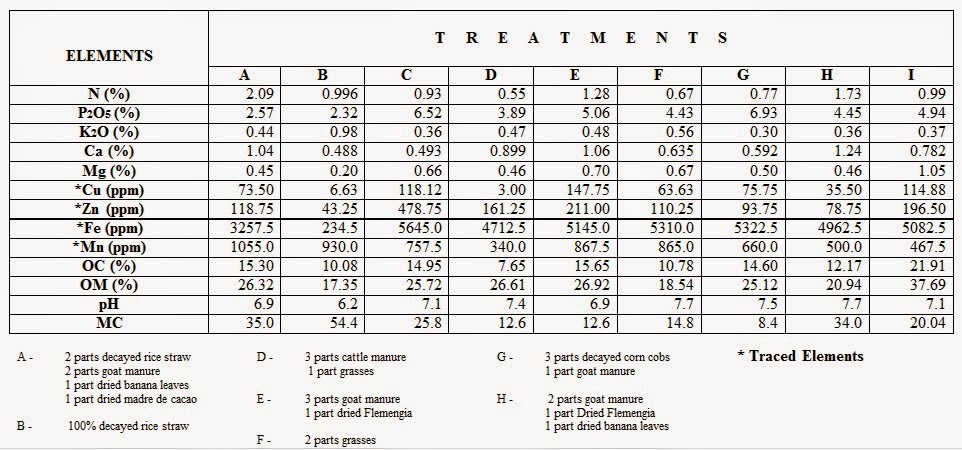I. INTRODUCTION
Vermicomposting is a process of production of organic fertilizer with an aid of earthworm (African Night Crawler Earthworm). The worms are fed with any farm wastes mixed with aged or dried feces of farm animals (substrates). In the absence of animal manure, this can be substituted with any available leguminous plant (Madre de cacao, ipil-ipil, flemengia, renzonii, etc.)
The earthworms are the main actor in the process because they are the ones that produce organic fertilizer through their feces or castings (vermicompost). Substrates are ingested by these worms and pass through their simple digestive tract. In the process of digestion, a capsule-like will be excreted called castings. Casting as organic fertilizer is comparable to “Guano” according to Capt. James Foz Reamon.
The availability of farm wastes that are normally wasted through burning can now be made productive through vermicomposting. Eventually, the problems of farmers on continuous rise of inorganic fertilizer will be eliminated. Soil fertility amelioration can also be gradually obtained by continues organic fertilizer application.
In urban communities, it is a very practical and environmental friendly way of converting waste materials into a beneficial resource without burning and disposing them to garbage collector. In the wet market where vegetables and other plants wastes abound can be a source of vermicomposting materials, thereby, helping the urban government in the problem of waste disposal.
Aside from the above-stated benefits, cash flow of farmers can also be increased because the breeder earthworms can be sold at Php1.00 or Php500.00 per kilo. Castings or vermicompost can also be sold at the maximum of Php10.00 per kilo (J.F. Reamon).
II. OBJECTIVE
This study was conducted to know the amount of Macro-elements and other traced elements found in the castings of earthworms fed with various farm and animal wastes.
III. SCOPE AND LIMITATION
This study is limited only on the determination of macro-elements and other traced elements found in the castings of worms. This was conducted on November 28, 2004 to February 18, 2005.
IV. MATERIALS USED
1. African Night Crawler Earthworm
2. Animal manure
3. Decayed rice straw
4. Dried grasses
5. Chopped dried banana leaves
6. Dried madre de cacao leaves
7. Dried Flemengia leaves
8. Saw dust
9. Decayed corn cobs
10. Hallow blocks
11. Slabs
12. Empty sacks/plastic sheets
13. Tap water
V. METHODOLOGY
1. Construction of worm bin – A two square meters (1m x 2m) hollow blocks and slabs worm bin was constructed to confine the worm. Empty sacks and plastic sheets were used as matting and lining to preserve moisture and to ensure that the worms will be intact in the bin.
2. Putting of substrates – This was done like preparing a hamburger. Layering by approximately 2 inches was done for each of the feeding materials used. The sequence was applied up to the level of 8 inches height of the piles.
3. Stocking the worms – The worms were distributed around the piled substrates.
4. Watering – Watering was done once a week on shaded bins while on open bins watering was done (required in the absence of rain during the week) twice a week. Two (2) to three (3) gallons of tap water per watering period was enough to bin measuring 1 meter width by two meters length.
5. Collection of samples – The sample castings were collected two months after the introduction of the worms. The samples were air-dried for 24 hours and subjected to laboratory examination by the Department of Agriculture Regional Soils Laboratory, Davao City on February, 2005.
6. Treatments – The research beneficiaries in 7 different locations implemented each treatment with different materials used. The treatments were as follows:
> Treatment A (Babiera) – Hagonoy
- 2 parts decayed rice straw
- 2 parts goat manure
- 1 part dried banana leaves
- 1 part madre de cacao
> Treatment B (Babiera) – Hagonoy
- 100% decayed rice straws
> Treatment C (Pedrosa/Babiera) - PPO1
- 3 parts grasses
- 1 part hog manure
> Treatment D (Pedrosa/Babiera) – PPO1
- 3 parts cattle manure
- 1 part dried grasses
> Treatment E (Llanto) – AT Mabini
- 3 parts goat manure
- 1 part dried flemengia leaves
> Treatment F (Lanaja) –BEW Nabunturan
- 2 parts grasses
- 1 part carabao manure
- 1 part goat manure
> Treatment G (Sarmiento/Malayan)-ATs Pantukan and Laak
- 3 parts Corn cobs
- 1 part goat manure
> Treatment H (Alfaro/Samal) –BEWs/FTGs Pantukan / New Bataan
- 2 parts goat manure
- 1 part dried flemengia leaves
- 1 part dried banana leaves
> Treatment I (Berdon/Villafuerte/Calipusan) –MED/AT New Bataan and FTG Laak respectively)
- 3 parts sawdust
- 1 part hog manure
VI. RESULTS
After subjecting to laboratory (Bureau of Soils, DA-RFU XI) examination, it was found that:
VII. FINDINGS/RECOMMENDATION
Based on the results of the laboratory examination of each treatment the quality of organic fertilizer (vermicompost) is dependent on the kinds of substrates or feeding materials fed to earthworms. Goat manure mixed with leguminous substrates (treatments A, E & H) found to have higher Nitrogen content compared to other treatments (cattle and hog manure with grasses). However, treatments that were fed with corncobs and grasses (treatments C&G) found to have high in phosphorous and treatment fed with pure decayed rice straws (treatment B) got the highest potassium content.
It is therefore recommended that before starting a vermicomposting project, the objective must be clearly set (i.e. what organic fertilizer composition is required for a specific area where the organic fertilizer produced will be applied) in order that appropriate substrates (as per laboratory examination results) will be prepared and be fed to the worms.
It is further recommended that vermicomposting project be promoted to all farmers in order to solve the problem on high cost of inorganic fertilizer that consequently lessen farm income.























1 comments:
What quantity and frequency of Vermicompost application for dragon fruit plant is practiced at your farm ?
Post a Comment